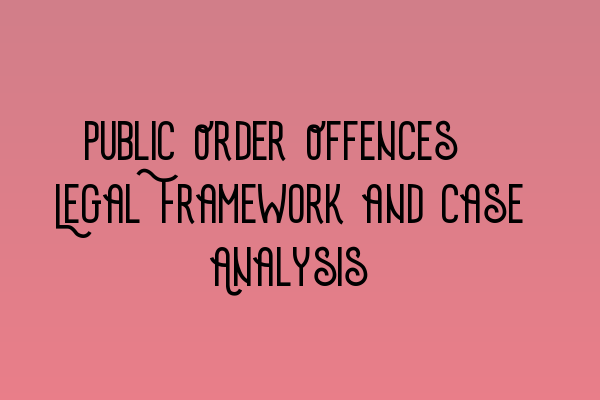Public Order Offences: Legal Framework and Case Analysis
Welcome to the SQE Criminal Law & Practice Law UK blog, where we provide expert insights and analysis on various legal topics. In this article, we will delve into the legal framework surrounding public order offences and examine some notable case studies. Public order offences are a significant area of criminal law, and understanding the key principles is crucial for aspiring solicitors.
The Legal Framework
Public order offences encompass a range of actions that disrupt public peace and tranquility. These offences are outlined in various statutes, including the Public Order Act 1986 and the Criminal Justice and Public Order Act 1994. Common public order offences include rioting, affray, violent disorder, and public nuisance.
Under the Public Order Act 1986, rioting involves the participation in a violent disorder by a group of three or more individuals. Affray, on the other hand, refers to the use or threat of unlawful violence that causes others present to fear for their safety. Violent disorder encompasses incidents where three or more persons use or threaten violence, causing a reasonable person to fear for their safety. Lastly, public nuisance involves any act that causes annoyance, inconvenience, or harm to the public. Each offence has its own specific elements that must be proven for a conviction.
Case law plays a significant role in interpreting and shaping the legal framework of public order offences. To gain a comprehensive understanding, it is essential to examine relevant case studies, such as R v Chalmers (1996), R v Curtis-Smith (2017), and R v Howell (2005). These cases provide insights into the application of the law and how different elements are interpreted by the courts. By analyzing these cases, solicitors can gain valuable knowledge to effectively represent their clients in public order cases.
Case Analysis: R v Chalmers (1996)
In the case of R v Chalmers, the defendant was charged with affray after a heated argument in a public place led to threats and aggressive behavior. The court held that the defendant’s actions had caused fear and unrest among the public, thereby satisfying the element of affray. This case highlights the importance of proving a reasonable person’s fear or distress when establishing an affray offense.
Case Analysis: R v Curtis-Smith (2017)
R v Curtis-Smith involved a large-scale protest where protestors clashed with police officers and caused significant disruption. The court, in this case, emphasized the distinction between protest and violent disorder. The defendant’s actions, which went beyond peaceful demonstration and involved violence, were deemed to constitute a violent disorder offense. This case demonstrates the significance of distinguishing between protected peaceful assembly and unlawful disturbances that infringe upon public order.
Case Analysis: R v Howell (2005)
In R v Howell, the defendant was charged with public nuisance for repeatedly setting off loud fireworks late at night, causing annoyance and distress to the neighborhood. The court held that the defendant’s actions were unreasonable and interfered with the public’s right to enjoy peace. This case highlights the importance of considering the impact of an act on the public when evaluating charges of public nuisance.
Understanding the legal framework and analyzing relevant case law are crucial for effectively navigating public order offences as a solicitor. By staying up to date with recent developments and interpretations, you can provide the best possible representation for your clients.
If you’re preparing for the SQE 1 or SQE 2 exams, be sure to check out our related articles:
- SQE 1 Practice Exam Questions
- SQE 1 Practice Mocks FLK1 FLK2
- SQE 2 Preparation Courses
- SQE 1 Preparation Courses
- SRA SQE Exam Dates
At SQE Criminal Law & Practice Law UK, we offer comprehensive preparation courses for the SQE exams, ensuring you have the knowledge and skills to succeed. Stay tuned for more informative articles and updates on criminal law and practice!
